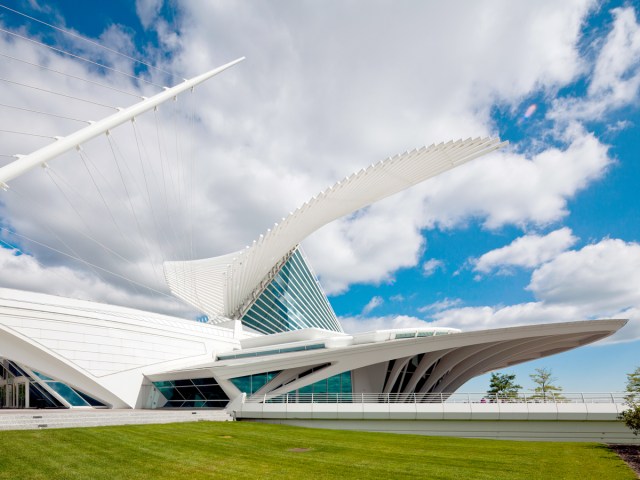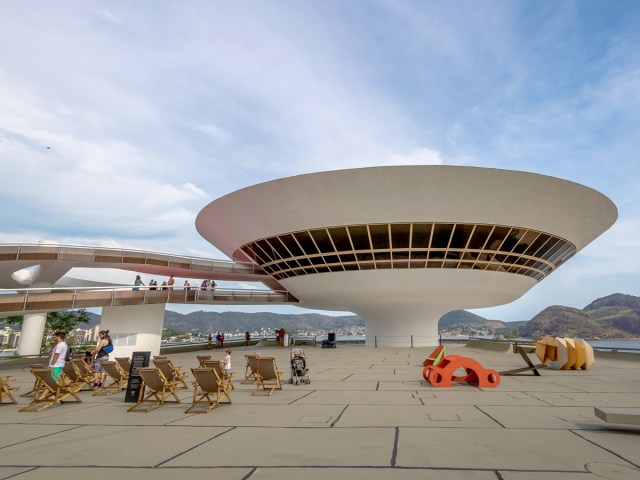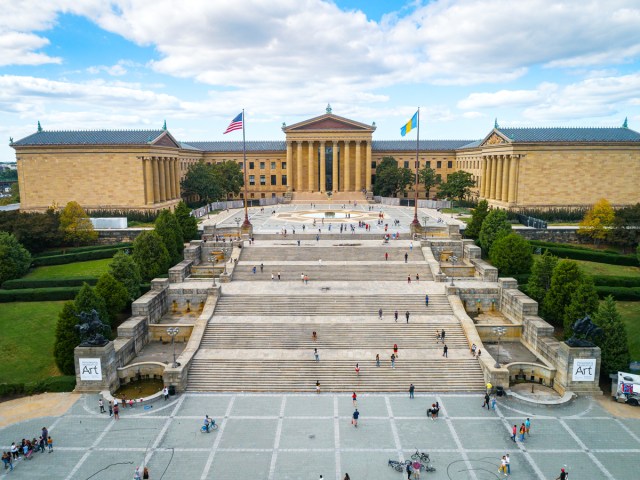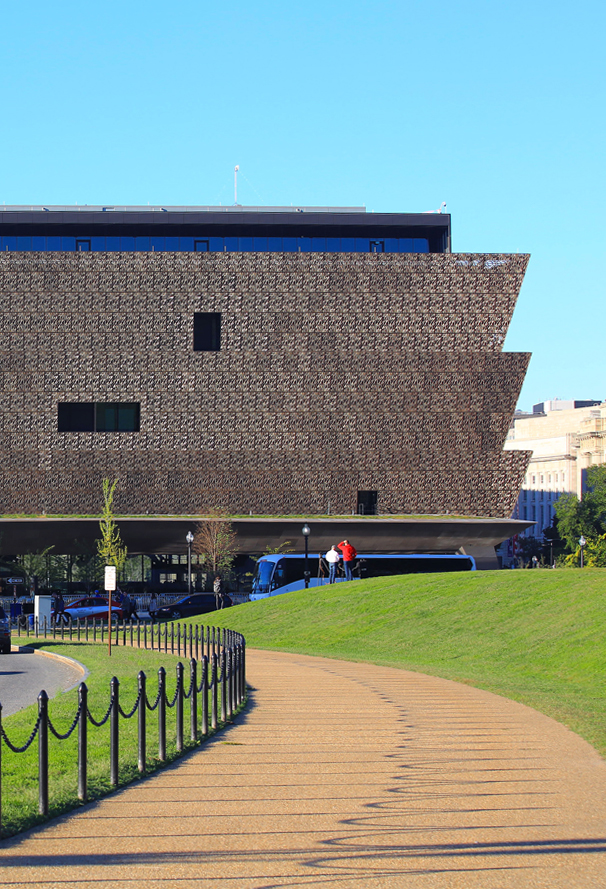Museums are usually famous for what lies inside them — paintings, sculptures, photographs, and other priceless works that span centuries of human culture and artistic achievement. Yet, many of the buildings that house these famous works and historical artifacts also happen to be masterpieces themselves. From the unmissable “flying saucer” that overlooks Rio de Janeiro to a museum so architecturally significant that it revitalized the economy of a Spanish city, discover six of the most architecturally stunning museums across the globe.
Milwaukee Art Museum – Wisconsin

Its collection is estimable — think 32,000-plus works spanning millennia and genres — but the Milwaukee Art Museum is also the kind of place you could easily visit for the architecture alone. A trifecta of modern masters is represented here, placing the complex squarely on the world stage: There’s Eero Saarinen’s 1957 modernist cross-shaped War Memorial Center, David Kahler’s 1957 brutalist addition, and Santiago Calatrava’s 2001 neo-futurist Quadracci Pavilion (often simply referred to as “the Calatrava”).
The latter is the most iconic of the three — so famous, in fact, that it’s become a visual stand-in for Milwaukee itself. No visit to the city is complete without experiencing the pavilion’s cathedral-evoking Windhover Hall, the giant avian-like Burke Brise Soleil (a moveable, 217-foot wing-like sunscreen that more or less flaps twice daily), and the pedestrian Reiman Bridge that connects the lakeshore museum to downtown.
Niterói Contemporary Art Museum – Brazil

Is it a flower or a flying saucer? Although undoubtedly futuristic, this gleaming white structure isn’t from another world. According to the architect, the answer is “flower,” but if aliens were to land, this cliffside location would be a fitting place.
Designed by Brazilian avant-garde architect Oscar Niemeyer, one of the founders of Modernist movement, the Niterói Contemporary Art Museum (Museu de Arte Contemporânea de Niterói, nicknamed the MAC by locals) was completed in 1996, located across the Bay of Guanabara from Rio de Janeiro in the nearby city of Niterói. Now celebrating its 25th anniversary, the stunning four-story circular museum boasts a permanent collection of more than 1,200 pieces, highlighting some of the country’s most iconic contemporary artists such as Lygia Clark and João Carlos Goldberg, in addition to a robust schedule of temporary exhibitions.
But the art, strangely enough, isn’t the focal point of the experience. Many visitors arrive by ferry (it’s only 20 minutes from Rio) and come simply for the building’s world-class architecture — not to mention the sweeping views of Sugarloaf Mountain, Guanabara Bay, and Praia da Boa Viagem beach.
National Museum of African American History and Culture – Washington, D.C.

The design of the National Museum of African American History and Culture — a collaboration of the Freelon Group, Adjaye Associates, and Davis Brody Bond — wraps the structure in an ornate lattice of bronze-colored metal. It features three tiers of inverted half-pyramids that invoke the Yoruba crowns of West Africa. The building opened on the National Mall in 2016 in a ceremony presided over by the nation’s first Black president, Barack Obama. The culmination of decades of effort, it’s the only national museum entirely dedicated to documenting the contributions of African Americans and to examining American history through their lens.
The museum’s permanent collection includes invaluable artifacts such as Harriet Tubman’s hymnal, a Tuskegee airplane, a reconstructed cabin for enslaved people from a South Carolina plantation, Louis Armstrong’s trumpet, a dress sewn by Rosa Parks, and boxing headgear worn by Muhammad Ali. Rotating exhibits explore history, culture, current events, and myriad facets of the African American experience. The museum is open Wednesday through Sunday with free timed admission — but be sure to book your tickets well in advance.
Guggenheim Museum – Bilbao, Spain

When it opened in 1997, this curvilinear titanium masterpiece by architect Frank Gehry may not have technically put Bilbao on the map — the city’s position on the Nervión River near the Bay of Biscay has assured the port’s significance for centuries — but the museum quickly exerted what experts termed “the Bilbao Effect.” It refers to the ability to turn a once-overlooked city into a tourist hotspot with trophy architecture. See also: the Louvre Abu Dhabi, and by 2025, the Gehry-designed Guggenheim Abu Dhabi.
In the case of the Guggenheim Bilbao, before the pandemic, more than a million annual visitors arrived to behold the waterside museum’s famed swirls and the galleries therein. The permanent collections include major works by Jenny Holzer, Richard Serra, and Jeff Koons, among many others. But perhaps the most recognizable sculpture, which accessorizes many a shot of the museum’s exterior, is the spindly spider known as Maman, by Louise Bourgeois.
Philadelphia Museum of Art – Philadelphia, Pennsylvania

Sylvester Stallone made the grand steps outside this museum famous by racing up them in the Rocky films, but the Philadelphia Museum of Art had been around for a whole century before that. Home to over 240,000 objects, it is among the largest and most-visited art museums in the world. Originally located outside Center City, the museum now overlooks the city’s Benjamin Franklin Parkway — a grand thoroughfare lined with civic structures and museums. The building opened in 1938 and was inspired by Greek temples, clad in dolomite, and adorned with bronze gryphons.
The collection is truly out of this world: 200 galleries span 2,000 years of art history, with highlights that include paintings by El Greco, Manet, Monet, Picasso, Dalí, Duchamp, Brânçusi, and Twombly. There are also fantastic garments on display, including Grace Kelly’s wedding dress and pieces by Elsa Schiaparelli, and a massive collection of suits of armor from the medieval period. Finally, the museum’s magnificent Asian wing includes a full Japanese teahouse and garden, a Chinese palace hall, and an Indian temple for visitors to explore.
Centre Pompidou – Paris, France

When French President Georges Pompidou held a design contest in 1969 for the arts complex he envisioned in Paris’ Beaubourg district, no fewer than 681 entries streamed in. One of the last and most improbable designs to arrive — a radical “inside-out” building by Renzo Piano and Richard Rogers that would come to define the latter’s career — won the commission. The conspicuously colorful and exposed external ducts, among other elements that would normally remain hidden inside a building, would certainly “faire crier” (cause a stir), as Pompidou put it. And that they did.
But despite the polarized response from both the public and press that met the Centre’s opening in the beginning of 1977, the building still managed to draw historic crowds. Only five months later, The New York Times reported that nearly 3 million people visited — more than the combined yearly total for the Louvre and Napoleon’s Tomb at the time. Though today it is the city’s third-most visited site after the Eiffel Tower and the Louvre, the Centre Pompidou remains one of the world’s most iconic contemporary art centers.
More from our network
Daily Passport is part of Optimism, which publishes content that uplifts, informs, and inspires.























